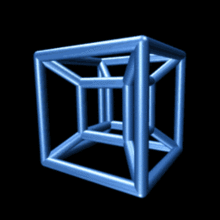Demihypercube
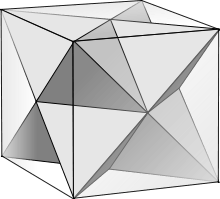
In geometry, demihypercubes (also called n-demicubes, n-hemicubes, and half measure polytopes) are a class of n-polytopes constructed from alternation of an n-hypercube, labeled as hγn for being half of the hypercube family, γn. Half of the vertices are deleted and new facets are formed. The 2n facets become 2n (n-1)-demicubes, and 2n (n-1)-simplex facets are formed in place of the deleted vertices.[1]
They have been named with a demi- prefix to each hypercube name: demicube, demitesseract, etc. The demicube is identical to the regular tetrahedron, and the demitesseract is identical to the regular 16-cell. The demipenteract is considered semiregular for having only regular facets. Higher forms don't have all regular facets but are all uniform polytopes.
The vertices and edges of a demihypercube form two copies of the halved cube graph.
Discovery
Thorold Gosset described the demipenteract in his 1900 publication listing all of the regular and semiregular figures in n-dimensions above 3. He called it a 5-ic semi-regular. It also exists within the semiregular k21 polytope family.
The demihypercubes can be represented by extended Schläfli symbols of the form h{4,3,...,3} as half the vertices of {4,3,...,3}. The vertex figures of demihypercubes are rectified n-simplexes.
Constructions
They are represented by Coxeter-Dynkin diagrams of three constructive forms:




 ...
... (As an alternated orthotope) s{21,1...,1}
(As an alternated orthotope) s{21,1...,1}


 ...
...
 (As an alternated hypercube) h{4,3n-1}
(As an alternated hypercube) h{4,3n-1}


 ...
...
 . (As a demihypercube) {31,n-3,1}
. (As a demihypercube) {31,n-3,1}
H.S.M. Coxeter also labeled the third bifurcating diagrams as 1k1 representing the lengths of the 3 branches and lead by the ringed branch.
An n-demicube, n greater than 2, has n*(n-1)/2 edges meeting at each vertex. The graphs below show less edges at each vertex due to overlapping edges in the symmetry projection.
| n | 1k1 | Petrie polygon |
Schläfli symbol | Coxeter diagrams A1n Bn Dn |
Elements | Facets: Demihypercubes & Simplexes |
Vertex figure | |||||||||
|---|---|---|---|---|---|---|---|---|---|---|---|---|---|---|---|---|
| Vertices | Edges | Faces | Cells | 4-faces | 5-faces | 6-faces | 7-faces | 8-faces | 9-faces | |||||||
| 2 | 1-1,1 | demisquare (digon)  |
s{2} h{4} {31,-1,1} |
2 | 2 | 2 edges |
-- | |||||||||
| 3 | 101 | demicube (tetrahedron)   |
s{21,1} h{4,3} {31,0,1} |
4 | 6 | 4 | (6 digons) 4 triangles |
Triangle (Rectified triangle) | ||||||||
| 4 | 111 | demitesseract (16-cell) 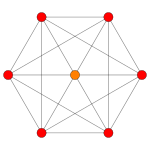  |
s{21,1,1} h{4,3,3} {31,1,1} |
8 | 24 | 32 | 16 | 8 demicubes (tetrahedra) 8 tetrahedra |
Octahedron (Rectified tetrahedron) | |||||||
| 5 | 121 | demipenteract  |
s{21,1,1,1} h{4,33}{31,2,1} |
16 | 80 | 160 | 120 | 26 | 10 16-cells 16 5-cells |
Rectified 5-cell | ||||||
| 6 | 131 | demihexeract 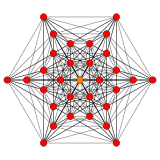 |
s{21,1,1,1,1} h{4,34}{31,3,1} |
32 | 240 | 640 | 640 | 252 | 44 | 12 demipenteracts 32 5-simplices |
Rectified hexateron | |||||
| 7 | 141 | demihepteract  |
s{21,1,1,1,1,1} h{4,35}{31,4,1} |
64 | 672 | 2240 | 2800 | 1624 | 532 | 78 | 14 demihexeracts 64 6-simplices |
Rectified 6-simplex | ||||
| 8 | 151 | demiocteract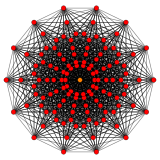  |
s{21,1,1,1,1,1,1} h{4,36}{31,5,1} |
128 | 1792 | 7168 | 10752 | 8288 | 4032 | 1136 | 144 | 16 demihepteracts 128 7-simplices |
Rectified 7-simplex | |||
| 9 | 161 | demienneract  |
s{21,1,1,1,1,1,1,1} h{4,37}{31,6,1} |
256 | 4608 | 21504 | 37632 | 36288 | 23520 | 9888 | 2448 | 274 | 18 demiocteracts 256 8-simplices |
Rectified 8-simplex | ||
| 10 | 171 | demidekeract  |
s{21,1,1,1,1,1,1,1,1} h{4,38}{31,7,1} |
512 | 11520 | 61440 | 122880 | 142464 | 115584 | 64800 | 24000 | 5300 | 532 | 20 demienneracts 512 9-simplices |
Rectified 9-simplex | |
| ... | ||||||||||||||||
| n | 1n-3,1 | n-demicube | s{21,1,...,1} h{4,3n-2}{31,n-3,1} |
2n-1 | n (n-1)-demicubes 2n (n-1)-simplices |
Rectified (n-1)-simplex | ||||||||||
In general, a demicube's elements can be determined from the original n-cube: (With Cn,m = mth-face count in n-cube = 2n-m*n!/(m!*(n-m)!))
- Vertices: Dn,0 = 1/2 * Cn,0 = 2n-1 (Half the n-cube vertices remain)
- Edges: Dn,1 = Cn,2 = 1/2 n(n-1)2n-2 (All original edges lost, each square faces create a new edge)
- Faces: Dn,2 = 4 * Cn,3 = n(n-1)(n-2)2n-3 (All original faces lost, each cube creates 4 new triangular faces)
- Cells: Dn,3 = Cn,3 + 2n-4Cn,4 (tetrahedra from original cells plus new ones)
- Hypercells: Dn,4 = Cn,4 + 2n-5Cn,5 (16-cells and 5-cells respectively)
- ...
- [For m=3...n-1]: Dn,m = Cn,m + 2n-1-mCn,m+1 (m-demicubes and m-simplexes respectively)
- ...
- Facets: Dn,n-1 = n + 2n ((n-1)-demicubes and (n-1)-simplices respectively)
Symmetry group
The symmetry group of the demihypercube is the Coxeter group [3n-3,1,1] has order and is an index 2 subgroup of the hyperoctahedral group (which is the Coxeter group [4,3n-1]). It is generated by permutations of the coordinate axes and reflections along pairs of coordinate axes.[2]
Orthotopic constructions

Constructions as alternated orthotopes have the same topology, but can be stretched with different lengths in n-axes of symmetry.
The rhombic disphenoid is the three-dimensional example as alternated cuboid. It has three sets of edge lengths, and scalene triangle faces.
See also
References
- ↑ Regular and semi-regular polytopes III, p. 315-316
- ↑ http://math.ucr.edu/home/baez/week187.html
- T. Gosset: On the Regular and Semi-Regular Figures in Space of n Dimensions, Messenger of Mathematics, Macmillan, 1900
- John H. Conway, Heidi Burgiel, Chaim Goodman-Strass, The Symmetries of Things 2008, ISBN 978-1-56881-220-5 (Chapter 26. pp. 409: Hemicubes: 1n1)
- Kaleidoscopes: Selected Writings of H.S.M. Coxeter, editied by F. Arthur Sherk, Peter McMullen, Anthony C. Thompson, Asia Ivic Weiss, Wiley-Interscience Publication, 1995, ISBN 978-0-471-01003-6
- (Paper 24) H.S.M. Coxeter, Regular and Semi-Regular Polytopes III, [Math. Zeit. 200 (1988) 3-45]
External links
- Olshevsky, George. "Half measure polytope". Glossary for Hyperspace. Archived from the original on 4 February 2007.
| Fundamental convex regular and uniform polytopes in dimensions 2–10 | ||||||||||||
|---|---|---|---|---|---|---|---|---|---|---|---|---|
| Family | An | Bn | I2(p) / Dn | E6 / E7 / E8 / E9 / E10 / F4 / G2 | Hn | |||||||
| Regular polygon | Triangle | Square | p-gon | Hexagon | Pentagon | |||||||
| Uniform polyhedron | Tetrahedron | Octahedron • Cube | Demicube | Dodecahedron • Icosahedron | ||||||||
| Uniform 4-polytope | 5-cell | 16-cell • Tesseract | Demitesseract | 24-cell | 120-cell • 600-cell | |||||||
| Uniform 5-polytope | 5-simplex | 5-orthoplex • 5-cube | 5-demicube | |||||||||
| Uniform 6-polytope | 6-simplex | 6-orthoplex • 6-cube | 6-demicube | 122 • 221 | ||||||||
| Uniform 7-polytope | 7-simplex | 7-orthoplex • 7-cube | 7-demicube | 132 • 231 • 321 | ||||||||
| Uniform 8-polytope | 8-simplex | 8-orthoplex • 8-cube | 8-demicube | 142 • 241 • 421 | ||||||||
| Uniform 9-polytope | 9-simplex | 9-orthoplex • 9-cube | 9-demicube | |||||||||
| Uniform 10-polytope | 10-simplex | 10-orthoplex • 10-cube | 10-demicube | |||||||||
| Uniform n-polytope | n-simplex | n-orthoplex • n-cube | n-demicube | 1k2 • 2k1 • k21 | n-pentagonal polytope | |||||||
| Topics: Polytope families • Regular polytope • List of regular polytopes and compounds | ||||||||||||
